Putting people in the sky not only requires tall structures to support them and mechanical systems to bring them power and water; it also requires a variety of more mundane services to look after them day to day. These services include office cleaning and trash removal, security, monitoring and maintenance of ventilation and elevator systems, and window and façade cleaning.
In residential towers, routine maintenance will generally be the responsibility of the landlord if it’s a rental building, or of an organization of owners if it’s not. In both cases, a third-party management firm will generally be hired to manage the building day to day. In commercial skyscrapers landlords or owners may also hire a third- party entity to operate and maintain the building or, if they own enough buildings to support a dedicated maintenance staff, do it with their own employees.
Routine cleaning is an important part of skyscraper maintenance. In residential towers the building’s management will be responsible for cleaning only the common areas. In commercial buildings the landlord will be responsible for common areas, but may also contract to clean individual office suites as well. In both cases the level and extent of cleaning is left to the owners and tenants.
In contrast, the nature and scope of other maintenance tasks is often determined by municipal regulations. Local governments usually require certain levels of façade inspection and maintenance to protect both building occupants and pedestrians on the street below. They will also typically require regular elevator inspections and may mandate periodic building air quality testing and inspections as well.
How old are the world’s skyscrapers?
The average age of the top 25 tallest buildings in cities around the world varies dramatically by continent. Many of the skyscrapers in North America and Europe are decades into their useful life and will soon require upgrades to systems and components. The cities of Asia and the Middle East have younger building stock, much of which won’t require major reinvestment for some time.
Although the annual cost of maintenance work pales in comparison to the cost of constructing a building, over the life of a building—which can be upward of 100 years—it is much more significant. Holding aside capital replacement and reinvestment, the cost of the initial structure itself represents only about 5 to 10 percent of the total cost of owning a building over a 30-year period. Operations and maintenance-related costs, however, represent 60 to 85 percent. (Land acquisition, predevelopment planning, and disposal account for the balance of its life-cycle costs.)

 DUBAI—SHANGAI
GHANGZHOU HONG KONG; SEOUL SÃO PAULO TOKYO TORONTO SINGAPORE; SYDNEY CHICAGO
LONDON MOSCOW LOS ANGELES HOUSTON NEW YORK.
DUBAI—SHANGAI
GHANGZHOU HONG KONG; SEOUL SÃO PAULO TOKYO TORONTO SINGAPORE; SYDNEY CHICAGO
LONDON MOSCOW LOS ANGELES HOUSTON NEW YORK.
Prior to the development of glass curtain wall, window washers on toll buildings wore a harness and hooked themselves into clips on the sides of building windows. They accessed the windows from inside the floor on were thus a familiar site to office workers.
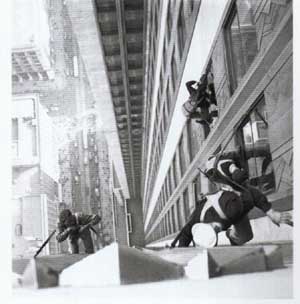
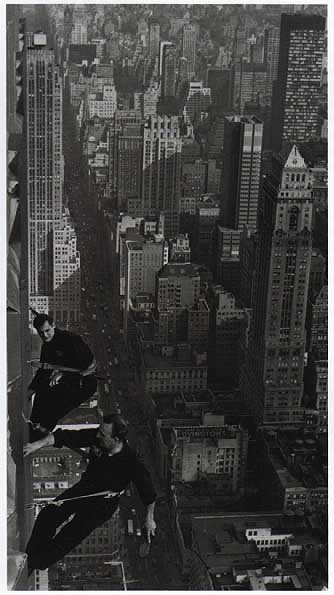
The high operating costs of managing a building reflect the fact that most maintenance work needs to be done by people rather than machines. Experiments with automated maintenance have been tried repeatedly but have rarely been successful. The earliest automated window- washing systems, For example, were piloted in Japan in the lg8os; similar attempts in Europe followed. Most failed miserably: the initial outlay for construction of these systems was high, they were expensive to maintain, and the cleaning they accomplished was generally inferior to that done by professional window washers.
People and Parts:
Skyscrapers must be managed around the clock. Even an office building, which is largely unoccupied after hours, must have a skeletal staff at night and on the weekends—to assist tenants who are working overtime, to oversee construction and maintenance work, or just to clean offices while employees aren’t there. As a result, most buildings employ a 24- hour shift system for important services, including security, engineering, portering and front-desk coverage.
Beyond day-to-day maintenance, there is a program of annual maintenance required to ensure that a building continues to operate safely—and to provide revenue—throughout as much of its zoo- year life span as possible. Periodic maintenance of a building is similar to that undertaken on a car: systems will be inspected and parts replaced regularly to protect against breakdown. But rather than mileage marking the maintenance milestones, buildings work in years: every five, 10, or even 25 years a certain part will need to be refurbished or replaced.
==
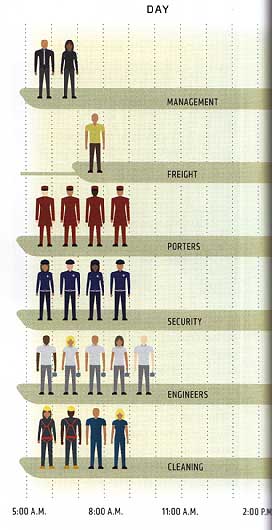
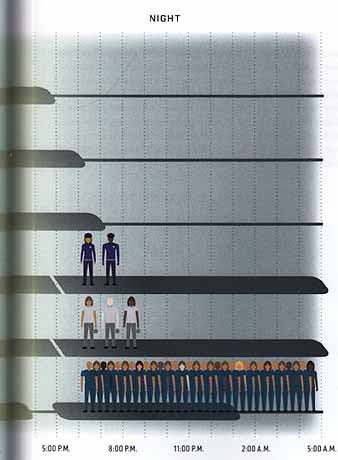
A day in the life of a skyscraper -- Behind the scenes, maintaining a skyscraper takes a small army of people. Though the number of people employed in servicing a building around the clock will vary with building size and use, a 50-story office tower might have 20 people looking after it during the day—and many more at night.
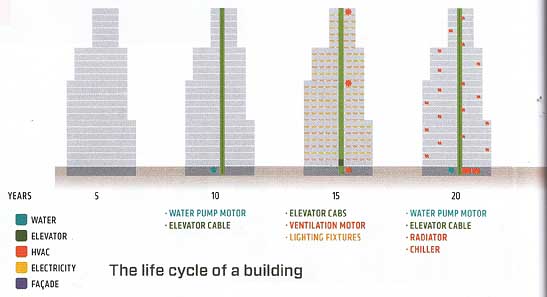
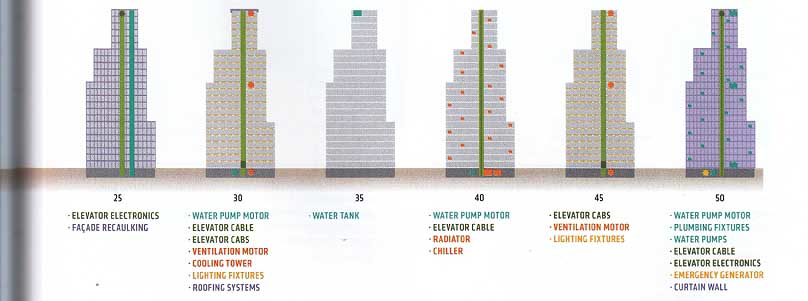
The life cycle of a building -- Some parts of a building are designed to last
their lifetime, such as piping, wiring, and large motors. But many other require
renovation or replacement from time to time. These include water pumps and
tanks, radiators, elevator components, lighting fixtures, façade and roofing
systems, and ventilation equipment.
• WATER
• ELEVATOR
• ELECTRICITY
• YEARS; DAY
MANAGEMENT
FREIGHT
PORTERS
SECURITY
5:00 A.M 8:00 AM. 11:00 AM. 2:00 PM
• WATER PUMP MOTOR ELEVATOR CABLE
ELEVATOR CABS • WATER PUMP MOTOR
• VENTILATION MOTOR ELEVATOR CABLE
LIGHTING FIXTURES
• RADIATOR
CHILLER
NIGHT MANAGEMENT -- A property manager is responsible for the day-to-day operation of the building. A tenant service coordinator interfaces daily with tenants and building management.
FREIGHT -- Several large-capacity elevators are operated by union-trained elevator operators and typically run from 7a.m. to 5p.m. unless scheduled for after-hours operation.
PORTERS -- The building’s common areas are serviced during business hours with a day staff of four porters; additional staffing may be provided directly to tenants for specific services.
SECURITY -- During normal business hours there are four security officers and a starter on duty. After hours, one officer is posted at the main lobby desk, and building access is by secure card only.
ENGINEERS -- Half a dozen engineers are typically on duty during the day to ensure smooth running of the building’s mechanical system. One or two will be on duty at night, doing preventive maintenance work.
CLEANING -- Three dozen full-time cleaning professionals work from 5p.m. to I am. Specialty cleaning services, such as window cleaning and metal or stone maintenance, occur on a periodic schedule during the day.
• ELEVATOR ELECTRONICS
• FACADE RE-CAULKING
WATER TANK
• WATER PUMP MOTOR ELEVATOR CABLE
• ELEVATOR CABS VENTILATION MOTOR
COOLING TOWER
LIGHTING FIXTURES
ROOFING SYSTEMS
WATER PUMP MOTOR ELEVATOR CABLE RADIATOR
CHILLER
• ELEVATOR CABS
• VENTILATION MOTOR LIGHTING FIXTURES
WATER PUMP MOTOR
• PLUMBING FIXTURES
• WATER PUMPS
• ELEVATOR CABLE ELEVATOR ELECTRONICS
• EMERGENCY GENERATOR CURTAIN WALL
Façade Cleaning:
Skyscraper façades were arguably simpler and easier to clean when their windows opened. Indeed, façade cleaning prior to 1950 primarily meant window washing, which was carried out by a dedicated crew of workers who would strap themselves into leather harnesses and hook themselves to the sides of skyscraper windows. Though the window ledges they stood on were tiny, they felt relatively safe: if one hook failed, they would be left dangling from the other.
But with the advent of the glass curtain wall building in the 1950s, windows effectively became the building façade. And because this façade was fixed—i.e., it didn’t open—window washing required access from the outside, and thus became infinitely more complex. To facilitate outside access for window cleaners, buildings had to be built with flat roofs to accommodate fixed or mobile window-washing equipment. A variety of mechanisms were developed to allow window-washing platforms to be suspended from rails or tracks atop a building roof, and to move up or down at the discretion of the operator.
Man vs. machine:
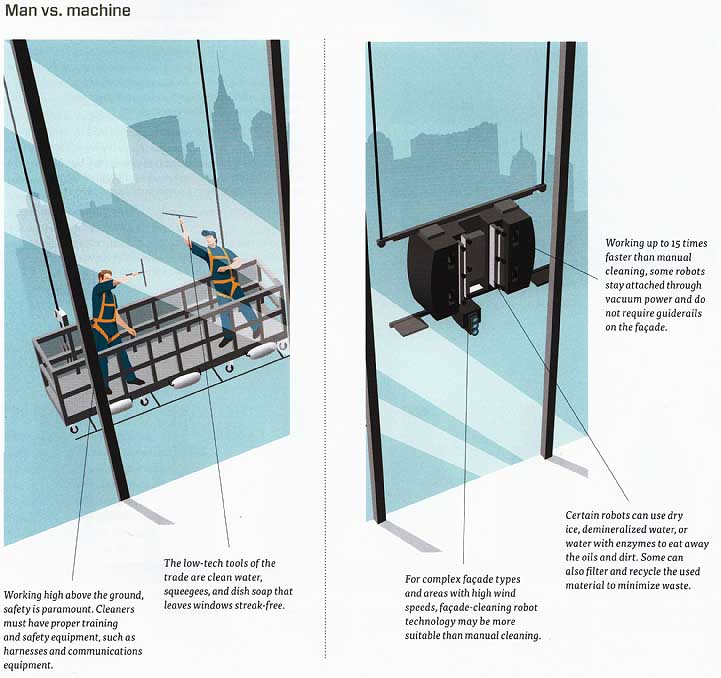
Working high above the ground, safety is paramount. Cleaners must have proper training and safety equipment, such as harnesses and communications equipment.
For complex façade types and areas with high wind speeds, façade-cleaning robot technology may be more suitable than manual cleaning.
Working up to is times faster than manual cleaning, some robots stay attached through vacuum power and don’t require guiderails on the façade.
Certain robots can use dry ice, de-mineralized water, or water with enzymes to eat away the oils and dirt. Some can also filter and recycle the used material to minimize waste.
The low-tech tools of the trade are clean water, squeegees, and dish soap that leaves windows streak-free.
As window-washing technology became more sophisticated, glass curtain wall buildings were able to break away from the mandatory flat-roofed silhouette. Slopes and multiple recesses, which had been prominent in designs during the first three decades of the 1900s (e.g., the Chrysler Building or the Empire State Building), began to reappear in skyscraper designs toward the end of the century. New forms of façade-access equipment were developed to serve these buildings, including arms that could act as supports for both window washing and hoisting.
Today window washing remains at the heart of a building’s periodic maintenance routine. Most windows will be washed twice a year, with the exception of ground-level retail and lobby entrances, which are done much more frequently. Nearly all of this work continues to be done by hand, although new experiments with automated cleaning robots—which rely on vacuum-powered suckers rather than guiderails to attach themselves to buildings—are under way in Europe and the Middle East.
==
Window-cleaning mechanisms:
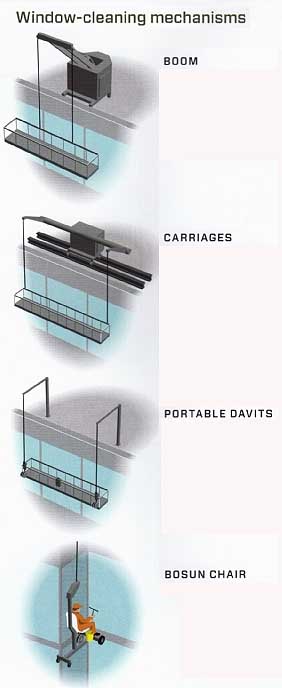
BOOM -- Designed for high-rise buildings, a boom system can allow complete façade maintenance access with nothing to assemble or disassemble at the roof level.
CARRIAGES -- Powered davit carriage units save the labor-intensive operation of moving portable davits. Like typical davit systems, the mast can be lowered out of view.
PORTABLE DAVITS -- One of the most economical solutions for façade access, portable davit masts move between fixed davit bases and can be lowered out of sight when not in use.
BOSUN CHAIR -- A powered bosun chair is designed for a single cleaner and can be operated from the chair itself.
==
Asian geometry:
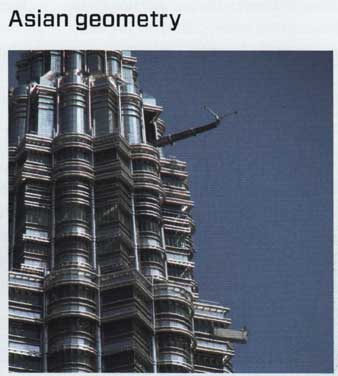
Access to the sides of a skyscraper is important not just for window washing but also for metal cleaning, inspection of curtain wall conditions, and the hoisting of replacement panels. In buildings with straight sides, this access is generally provided by a rig mechanism that is anchored on the roof and has the ability to move up or down fairly easily.
However, an increasing number of skyscrapers — particularly in Asia — do not have straight sides and distinguish themselves by twisting curtain walls or by multiple setbacks. As a result, the building designers must—at an early stage in design—select a façade access technology that will work with the building’s unusual geometry.
The Petronas Towers in Malaysia offer a good example of this complexity. Because of the towers’ multiple setbacks, traditional window-washing systems would be of little use. Instead, telescoping booms articulate out from hidden panels near the top of the structure, extending as far as needed to allow the cleaning rig to reach the protruding levels below.
==
Waste and Recycling:
Skyscraper operators are responsible for getting rid of the garbage produced by people living and working within it. This includes both putrescible waste, made up of food and other organic materials, and non-putrescible waste, such as paper and cardboard, aluminum, glass, and plastic. Most landlords will rely on waste haulers—either municipal or private, depending on the city—to remove both types of waste at regular intervals. For a reasonable-sized tower, these collections will generally occur once a day, often during early morning or evening hours.
To reduce the volume of waste being transported, building operators often rely on compactors located at the base of a building—usually located near freight elevators and loading docks. By shrinking the volume of waste anywhere from 10:1 to 25:1, these fairly simple machines greatly reduce the number of trips waste haulers must make—thus lowering the overall cost of garbage removal.
Building owners want to get rid of waste as soon as they can, and not only because it takes up space. In hot climates a buildup of putrescible waste can be problematic— creating smells and attracting animals. Large office buildings may deal with this by keeping food waste in a discrete, refrigerated storage area until it’s collected.
In some municipalities residential and commercial towers are required to separate recyclables. These typically include paper, glass, metal, and plastic. Recycling, like compaction, reduces the cost of traditional waste disposal by reducing the tonnage taken to landfills or incinerators.
==
The path(s) of American skyscraper waste:

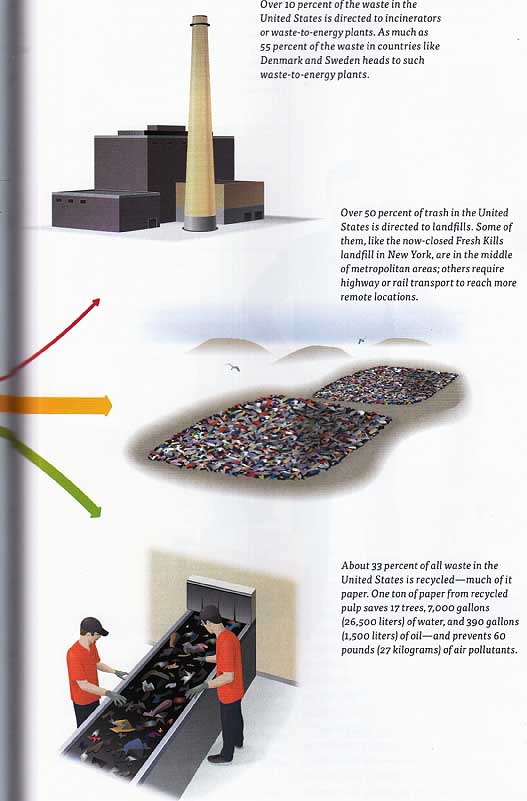
Waste from American skyscrapers typically finds its way to a variety of resting places. Much is recycled, including large volumes of paper, aluminum cans, and glass bottles. A certain amount may be burned in incinerators or waste-to-energy plants. Most of it, however, will find its way to landfills located in less Urban areas outside of the city—often in neighboring states.
If trash is not picked up on a daily basis, it may be held on-site in a compactor that can reduce trash volume to as little as 1/25th of its original size. Compactors are also useful in helping to discourage scavengers, reduce insect and rodent problems, control odor, and reduce fire hazards.
Public- or private-sector trash haulers pick up trash and recycling, and sometimes both. In New York City, far example, mast trash is hauled away from office buildings by private companies that pick up yesterday’s trash at night; trash from residential towers is collected during the day by the city
==
A stack of paper:

Over 10 percent of the waste in the United States is directed to incinerators or waste-to-energy plants. As much as 55 percent of the waste in countries like Denmark and Sweden heads to such waste-to-energy plants.
Over 50 percent of trash in the United States is directed to landfills. Some of them, like the now-closed Fresh Kills landfill in New York, are in the middle of metropolitan areas; others require highway or rail transport to reach more remote locations.
About 33 percent of all waste in the United States is recycled—much of it paper. One ton of paper from recycled pulp saves 17 trees, 7,000 gallons (26,500 liters) of water, and 390 gallons (1,500 liters) of oil—and prevents 60 pounds (27 kilograms) of air pollutants.
In recent years, almost 75 percent of high-grade office paper used in the United States has been recycled. On average, each American recycles about 340 pounds (154 kilograms) of it per year. For a very big building, regardless of whether it’s residential or commercial, that’s a lot of paper.
The Willis (Sears) Tower in Chicago provides a case in point. In 2008, workers there recycled 445 tons (400 metric tons) of paper. That’s a stack of paper each week as tall as the tower itself—and a savings of roughly 7,000 trees over the course of a year.
Cleaning:
Anyone who has ever had to work late in an office tower is familiar with the arrival of the office cleaner and his or her pushcart— generally early in the evening. Yet rarely if ever does one see them leave. That’s because their shift typically continues until midnight or beyond.
The cleaners who wander through office mazes at sundown are typically “generalists” responsible for undertaking a set of cleaning duties in a specific area or zone during a shift that usually lasts seven or eight hours. Other cleaners, known as “specialists,” will be responsible for heavier cleaning during that same period—taking care of things like the bathrooms or the carpets.
The amount of cleaning that goes on in an individual skyscraper can be enormous. In one year alone One Penn Plaza, a large commercial skyscraper in Midtown Manhattan, went through seven million sheets of paper towel and 850,000 trash bags. Cleaning costs in that building were forecast to exceed $6 million in 2010.
Although office cleaning is still very labor intensive, it has enjoyed its share of technological improvements over the years. The invention of microfiber cloth in the 1990s permitted dramatic improvements in the quality of office cleaning. Instead of simply pushing dirt and moisture around the surface, microfiber removes the dirt and water— reducing bacteria levels by three times the amount of traditional cotton rags.
Another invention that has found a home in office cleaning is deionized water. Traditional tap water is full of minerals (such as calcium, fluoride, chloride, and silica) that bond with minerals in glass and can leave streaks. Deionized water undergoes a filtration process that removes water’s negative charge; to stabilize itself the water will then seek out negative particles in the form of dirt or other contaminants and capture them—leaving windows streak-free and reducing the need for harmful chemicals.
==
Green cleaning:
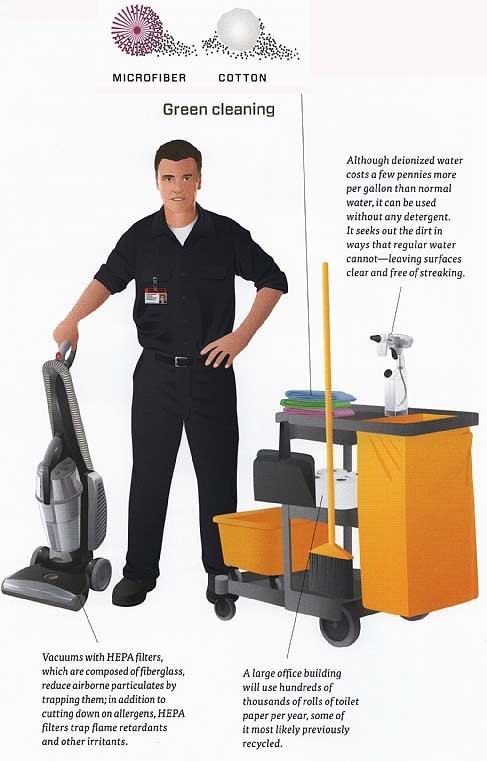
Green cleaning is a term that describes a growing trend of using cleaning methods with environment- friendly ingredients to preserve human health and environmental quality.
MICRO-FIBER vs. COTTON
Micro-fiber cloths are made of the same material that is used as insulation in sleeping bags and athletic clothing. They can holdup to seven times their weight in water and absorb oil and hold dirt much better than cotton cloth.
Although deionized water costs a few pennies more per gallon than normal water, it can be used without any detergent. It seeks out the dirt in ways that regular water cannot—leaving surfaces clear and free of streaking.
Vacuums with HEPA filters, which are composed of fiberglass, reduce airborne particulates by trapping them; in addition to cutting down on allergens, HEPA filters trap flame retardants and other irritants.
A large office building will use hundreds of thousands of rolls of toilet paper per year, some of it most likely previously recycled.
==
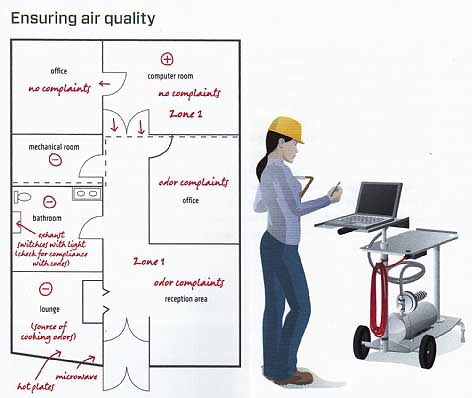
Ensuring air quality -- An air quality investigator will use pollutant pathway maps to understand airflow patterns and identify contaminant sources in the building.
A vacuum pump with o known airflow rate draws air through collection devices, such as a filter (which catches airborne particles), a sorbent tube (which attracts certain chemical vapors to o powder such as carbon), or an impinger (which bubbles the contaminants through a solution in a test tube).
==
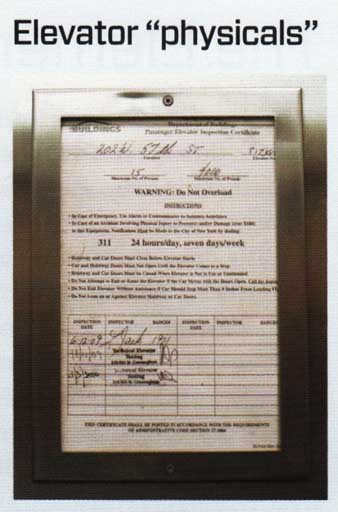
Elevator “physicals”:
Regular elevator inspections focus on the condition of the shaft and sheave, the lubrication of the governor, the doors on floors, and the various relays and switches. In New York City, every five years the governor is calibrated and the counterweight balance is checked. Tachometer readings are done to check the elevator’s speed, and the governor is tripped at top speed with a full load to ensure a safe stop.
==
Testing and Inspection:
Each year various systems within a skyscraper are inspected to make sure they are in working order. These range from the heating, ventilation, and air-conditioning systems to the elevators and standpipes. Local building regulations, often derived from national or international standards, govern what must be inspected when and set minimum standards of performance.
Elevator inspections are typically mandated by such municipal codes. In some places these inspections are carried out by contractors engaged by the local building department; in other places the building’s owner is asked to hire a licensed elevator contractor to perform the requisite inspection.
The nature of periodic inspections of elevators varies somewhat from city to city, In New York City, For example, three inspections are required over a period of two years and five inspections are required over a three-year period. A no-load safety test must be done every other year, while a full-load test—including running the elevator into the buffers at the bottom of the shaft—must be carried out only once every five years.
Air quality in tall buildings can also be subject to local regulation. With so many human bodies in an enclosed space, a supply of fresh air is important to dilute the large amount of carbon dioxide being produced by people in the building. Municipal codes, generally based on national or international standards, specify how many cubic feet per minute of outside air must circulate per building occupant.
The circulation of fresh air is also important to minimize the possibility of contamination—which can occur as a result of biological growth within the building (bacteria or molds) or of chemical products used inside or outside (e.g., adhesives, copy machines, or pesticides). In a high-rise structure such contamination—while unlikely—could potentially spread rapidly from a building’s mechanical equipment through its ventilation system to multiple floors and large numbers of people, as Legionnaire’s disease did some years back.
Referred to as “building-related illness,” this very real form of contamination is different from what is referred to as sick building syndrome.” Common symptoms of sick-building syndrome include respiratory complaints, irritation, and fatigue. Despite many reported cases, no causes of this syndrome have ever been found, and symptoms have generally been attributed to either environmental stress (heat, light, or noise) or to low levels of multiple pollutants in the building’s air, from carpets, or other chemical-laden products.
The Elements:
Regardless of whether a skyscraper finds itself in a temperate or tropical zone, it’s guaranteed to be subjected to the elements in a way shorter buildings are not. The sheer size and exposure of a tall building ensures that it will be less protected from sun, wind, rain, and snow. As a result, building designers and owners must undertake a variety of protective actions to ensure that neither the building nor its inhabitants are exposed to weather-related risks.
Managing rainfall is perhaps easier than managing other forms of precipitation. Adequate roof drainage must be provided not only on the roof, but also on any building setbacks where water could accumulate. Specially designed systems are installed to ensure the controlled flow of drainage on tall buildings, as the management of flow rates and water pressure is more complex at great heights than it’s with shorter drainpipes.
Snow can be more problematic. It can collect in large quantities in wind-blown drifts, placing great weight on certain parts of skyscrapers. Icicles can also be a danger during snowy weather. Each cubic foot of snow (.02 cubic meter) contains between two and three gallons (7 to i liters) of water. As the warm air in a building rises to melt the snow atop it, water runs down to the edge of the roof and freezes—often in the form of icicles, which hang down from ledges at great heights and can easily be blown off or fall.
==
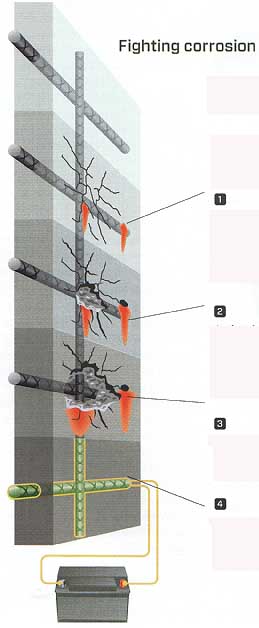
Fighting corrosion:
1. Chlorides, air, acid, and water penetrate the concrete surface. It con take anywhere from 10 to 15 years before the chloride ions and acid contaminants penetrate all the way to the reinforcing steel.
2. As the rebar corrodes, rust forms and can take up five to 10 times more volume than the original steel. This process puts forces on the concrete and ultimately leads to cracking, chipping, and delamination.
3. If untreated, the process will continue until the concrete becomes structurally unsound.
4. Cathodic protection works by minimizing the difference in electrical potential between parts of the steel by introducing a constant direct current from an external source—a technique that has proven highly effective in protecting underwater steel pipelines and ships.
==
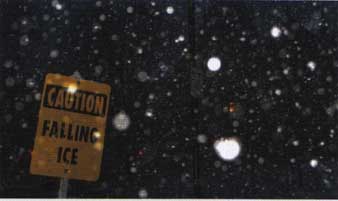
Falling ice:
Icicles falling from buildings are by no means a common occurrence, but they can prove a fatal one. At least one passerby was killed in Chicago in 2000 by a microwave-sized icicle falling from a building downtown, and fear of its happening elsewhere has led to the development of systems to prevent icicle formation on roof ledges.
Much of the work has been done in Canada and the Midwest, where long, tough winters are the norm. One system relies on hot water pipes inside the metal framework of the building to discourage ice formation. Another involves “deicing cables,” which create a heated drain path on the roof for me. Still a third involves the placement of heated “ice-melt panels” around the edges of a building.
But the most popular, and arguably most effective, method of avoiding injury to pedestrians walking at the base of skyscrapers is by far the simplest. “Caution, Falling Ice” signs are regularly seen on the sidewalks of Toronto, Boston, New York, Chicago, and other vertical cities in the north—reminding passers-by that sometimes there is no outsmarting Mother Nature.
Although buildings are built to last a century, their façades rarely do. Subjected to years of heat, snow, rain, and ice, curtain wall failures are common in older buildings and are usually the result of leaks or cracks that develop along surface seams over time. These cracks allow air and water to seep in, leading either to mold growth inside a curtain wall system or to deformation of the façade framework as a result of freezing and thawing.
In some cases marble panels have deteriorated to the point where they are no longer able to support their own weight. The Aon Center in Chicago and First Canadian Place in Toronto, both designed by Edward Durell Stone, replaced their façades after marble panels weighing hundreds of pounds fell to the ground. Similar recladding was undertaken on the Gulf & Western and the Verizon buildings in New York in 2006. Both were empty at the time, although recladding can also be done with tenants in place.
Steel-framed buildings clad in masonry can be particularly impacted by weather. Salt, moisture, and humidity can all lead to the formation of “corrosion cells” in reinforced concrete, which can lead to chipping or breakage. To protect against this, various forms of “cathodic protection,” involving the introduction of an electrical current to prevent corrosion, have been developed.
==
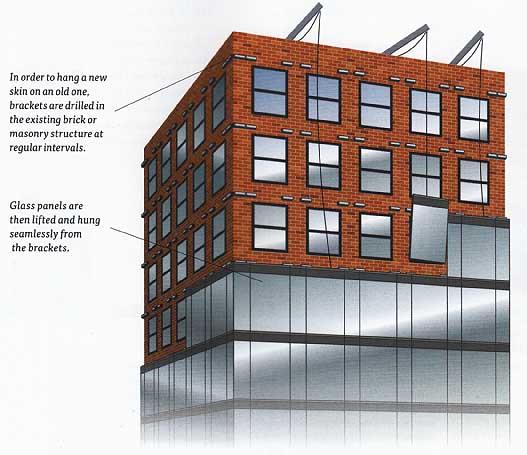
A skin transplant:
Re-cladding of a building is not always done for purely functional reasons and does not always involve replacement of the original curtain wall or skin. In some cases a glass curtain wall is erected on the outer side of a brick or masonry façade that stays in place—both to protect it from the elements and to give the building a more “modern” look. The by-product is a better-looking building—and of course a better insulated one as well.
In order to hang a new skin on an old one, brackets ore drilled in the existing brick or masonry structure at regular intervals
Glass panels are then lifted and hung seam from the brackets.
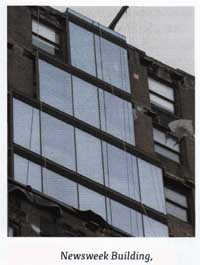
The former Newsweek Building, at Columbus Circle in New York City, shown in
the photo above, has recently completed a glass face-lift of this type.
Previous: Life Safety
Next: Sustainability